study pool
WE OFFER WELL RESEARCHED , CREDIBALE READING AND REVISION MATERIALS .
PAST PAPERS , EXAMS , TEST PAPERS AND QUIZ PAPERS ALL AVAILABLE
NURSING
MED SURG
SOFTWARE ENGINEERING
ENGINEERING
ECONOMICS
LAW
ART
BIOLOGY
MATH
CHEMISTRY
ETC.
- 453
- 0
- 17
Community
- Followers
- Following
1 Reviews received
470 items
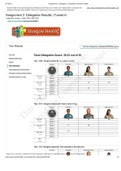
NURS 224 Assignment 2_ Delegation _ Completed _ Shadow Health Team Delegation - Johns Hopkins University
NURS 224 Assignment 2_ Delegation _ Completed _ Shadow Health Team Delegation - Johns Hopkins University
- Exam (elaborations)
- • 2 pages •
NURS 224 Assignment 2_ Delegation _ Completed _ Shadow Health Team Delegation - Johns Hopkins University
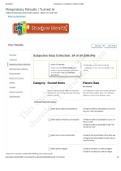
NUR 325 Respiratory_Subjective- Johns Hopkins University
NUR 325 Respiratory_Subjective- Johns Hopkins University Reports dust as asthma trigger Reports running quickly up stairs as asthma trigger Reports no asthma problems at work Reports no asthma problems at home
- Exam (elaborations)
- • 4 pages •
NUR 325 Respiratory_Subjective- Johns Hopkins University Reports dust as asthma trigger Reports running quickly up stairs as asthma trigger Reports no asthma problems at work Reports no asthma problems at home
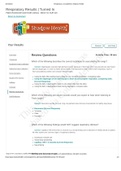
NUR 325 Respiratory_Review Questions- Johns Hopkins University
Adventitious lung sounds are abnormal, additional lung sounds, wheezes, crackles, rhonchi, stridor and pleural friction rub. There are two different types of crackles: coarse crackles and faint crackles. Coarse Crackles are usually heard in the upper airways. They are low-pitched and sound wet, with Jenson (2015) describing the sound as being similar to when you seperate velcro. Fine crackles, on the other hand, are high-pitched, crackling sound, usually heard in the lower lung fields. Jenso...
- Exam (elaborations)
- • 3 pages •
Adventitious lung sounds are abnormal, additional lung sounds, wheezes, crackles, rhonchi, stridor and pleural friction rub. There are two different types of crackles: coarse crackles and faint crackles. Coarse Crackles are usually heard in the upper airways. They are low-pitched and sound wet, with Jenson (2015) describing the sound as being similar to when you seperate velcro. Fine crackles, on the other hand, are high-pitched, crackling sound, usually heard in the lower lung fields. Jenso...
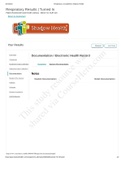
NUR 325 Respiratory_Documentation- Southern New Hampshire University
NUR 325 Respiratory_Documentation- Southern New Hampshire University COMPLETE
- Exam (elaborations)
- • 2 pages •
NUR 325 Respiratory_Documentation- Southern New Hampshire University COMPLETE
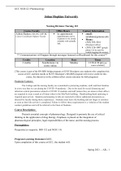
NUR_122_Spring_2021_Syllabus__2_ Pharmacology - Johns Hopkins University
Integrate theories and concepts from nursing, liberal arts, sciences, and humanities into professional nursing practice in a world of global interdependence. Course Learning Outcomes: 1. Students will develop respect, will value, and understand patients, families, and population preferences and values. (AACN: VI, VII, VIII, IX; QSEN: Teamwork & Collaboration, Patient-Centered Care, Safety
- Exam (elaborations)
- • 23 pages •
Integrate theories and concepts from nursing, liberal arts, sciences, and humanities into professional nursing practice in a world of global interdependence. Course Learning Outcomes: 1. Students will develop respect, will value, and understand patients, families, and population preferences and values. (AACN: VI, VII, VIII, IX; QSEN: Teamwork & Collaboration, Patient-Centered Care, Safety
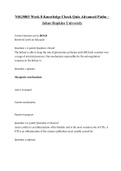
NSG5003 Week 1, 2 , 3 , 4, 5, 6, 7, 8, 8 knowledge check – Advanced Pathophysiology – Johns Hopkins University (A grade)
NSG5003 Week 1, 2 , 3 , 4, 5, 6, 7, 8, 8 knowledge check – Advanced Pathophysiology – Johns Hopkins University (A grade)
- Package deal
- • 8 items •
- NSG5003 Week 1 knowledge check – Johns Hopkins University (A grade) • Exam (elaborations)
- NSG5003 Week 2 knowledge check – Advanced Pathophysiology – Johns Hopkins University (A grade) • Exam (elaborations)
- NSG5003 Week 3 knowledge check – Advanced Pathophysiology – Johns Hopkins University (A grade) • Exam (elaborations)
- NSG5003 Week 5 knowledge check – Advanced Pathophysiology – Johns Hopkins University (A grade) • Exam (elaborations)
- NSG5003 Week 6 knowledge check – Advanced Pathophysiology – Johns Hopkins University (A grade) • Exam (elaborations)
- And more ….
NSG5003 Week 1, 2 , 3 , 4, 5, 6, 7, 8, 8 knowledge check – Advanced Pathophysiology – Johns Hopkins University (A grade)
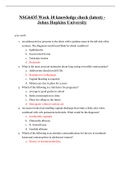
NSG6435 Week 1, 2, 3, 4, 5, 6, 7, 8, 9, 10 knowledge check (latest) - Johns Hopkins University
NSG6435 Week 1, 2, 3, 4, 5, 6, 7, 8, 9, 10 knowledge check (latest) - Johns Hopkins University COMPLETE
- Package deal
- • 10 items •
- NSG 6435 Pediatric Week 1 discussion - Johns Hopkins University • Exam (elaborations)
- NSG6435 Week 1 knowledge check (latest) - Johns Hopkins University • Exam (elaborations)
- NSG6435 Week 2 knowledge check (latest) - Johns Hopkins University • Exam (elaborations)
- NSG6435 Week 3 knowledge check (latest) - Johns Hopkins University • Exam (elaborations)
- NSG6435 Week 4 knowledge check (latest) - Johns Hopkins University • Exam (elaborations)
- And more ….
NSG6435 Week 1, 2, 3, 4, 5, 6, 7, 8, 9, 10 knowledge check (latest) - Johns Hopkins University COMPLETE

NSG 6435 Week 10 knowledge check (latest) - Johns Hopkins University
1. An adolescent boy presents to the clinic with a painless mass in the left side of his scrotum. The diagnosis would most likely be which condition? a. Epididymitis b. Incarcerated hernia c. Testicular torsion d. Hydrocele
- Package deal
- Exam (elaborations)
- • 2 pages •
1. An adolescent boy presents to the clinic with a painless mass in the left side of his scrotum. The diagnosis would most likely be which condition? a. Epididymitis b. Incarcerated hernia c. Testicular torsion d. Hydrocele
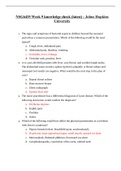
NSG6435 Week 9 knowledge check (latest) - Johns Hopkins University
1. The signs and symptoms of bacterial sepsis in children beyond the neonatal period has a common presentation. Which of the following would be the most typical? a. Cough, fever, abdominal pain b. Abdominal pain, diarrhea, vomiting c. Irritability, fever, lethargy d. Vesicular rash, pruritus, fever
- Package deal
- Exam (elaborations)
- • 2 pages •
1. The signs and symptoms of bacterial sepsis in children beyond the neonatal period has a common presentation. Which of the following would be the most typical? a. Cough, fever, abdominal pain b. Abdominal pain, diarrhea, vomiting c. Irritability, fever, lethargy d. Vesicular rash, pruritus, fever
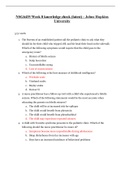
NSG6435 Week 8 knowledge check (latest) - Johns Hopkins University
1. The Parents of an established patient call the pediatric clinic to ask what they should do for their child who tripped, fell, and hit head their head on the sidewalk Which of the following symptoms would require that the child goes to the emergency room? a. History of febrile seizure b. Scalp laceration c. Uncontrollable crying d. Loss of consciousness
- Package deal
- Exam (elaborations)
- • 2 pages •
1. The Parents of an established patient call the pediatric clinic to ask what they should do for their child who tripped, fell, and hit head their head on the sidewalk Which of the following symptoms would require that the child goes to the emergency room? a. History of febrile seizure b. Scalp laceration c. Uncontrollable crying d. Loss of consciousness

ATI PN MENTAL HEALTH PROCTORED EXAM 2020